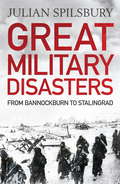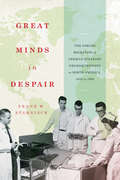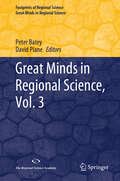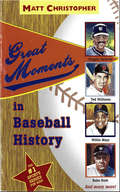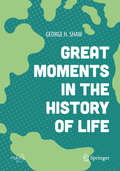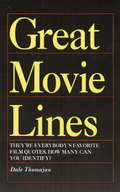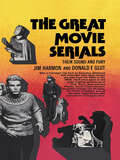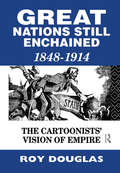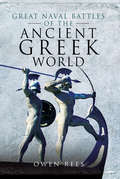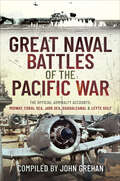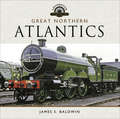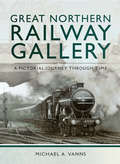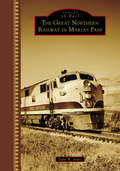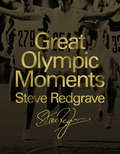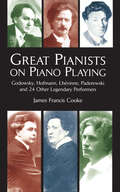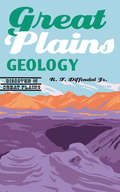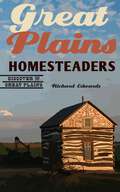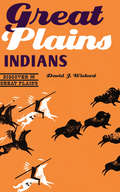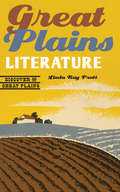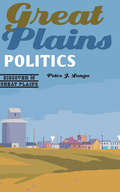- Table View
- List View
Great Military Disasters: From Cannae To Stalingrad
by Julian SpilsburyGreat Military Disasters tells the dramatic stories behind the world's most calamitous conflicts. From the French army's failure to understand the impact of new technology at Crécy to Hitler's blatant overconfidence at Stalingrad, military historian Julian Spilsbury provides thrilling accounts of each disaster, covering exactly what went wrong, how and why. Of course, a disastrous outcome for one side meant victory for another, so as well as exploring the reasons the conflict ended in disaster, Great Military Disasters also reveals the key to victory. Eyewitness quotations add another dimension to this intriguing study of human incompetence of the gravest kind.
Great Minds in Despair: The Forced Migration of German-Speaking Neuroscientists to North America, 1933 to 1989 (McGill-Queen's/AMS Healthcare Studies in the History of Medicine, Health, and Society)
by Frank W. StahnischThe twentieth century witnessed two devastating world wars that led to the exodus of millions of people. Counted among them were hundreds of neuroscientists and biological psychiatrists from Nazi Germany and its surrounding countries who were forced to emigrate in the 1930s and 1940s. Many of them settled in North America, where they profoundly influenced the development of the biomedical sciences.Focusing on the years between 1933 and 1989, Great Minds in Despair examines the long-term effects of this forced migration on scientific and medical cultures in North America and on the researchers themselves. Frank Stahnisch traces the lives and careers of approximately four hundred German-speaking doctors, scientists, and researchers over two generations. Placed in unfamiliar research settings in Canada and the United States, they helped to build the fields of neuroscience, psychiatry, clinical psychology, and the cognitive sciences, even as they rebuilt their own lives amid myriad challenges including cultural adaption and the complications of relicensing. Stahnisch explores how generational factors, gender, international networking, refugee organizations, and national funding agencies shaped their experiences and affected postwar remigration.Great Minds in Despair provides an important revision to the brain gain thesis in migration studies by turning attention to the working conditions and social acculturation of an influential academic refugee group in North America.
Great Minds in Regional Science, Vol. 3 (Footprints of Regional Science)
by Peter Batey David PlaneThis book is the third volume in a series on 'Great Minds in Regional Science,' which seeks to present a contemporary view on the scientific relevance of the work done by great thinkers in regional science. This volume presents, among others, Walter Christaller, Benjamin H. Stevens, William Alonso, and François Perroux. Each chapter combines factual biographical information about the &‘Great Mind,&’ a description of their major contributions, and a discussion of the broader context of their work, as well as an assessment of its current relevance, scientific recognition, and policy impact. The book attempts to fill a gap in our knowledge and to respond to the growing interest in the formation and development of the field of regional science and its key influential figures.
Great Moments in Baseball History
by Matt ChristopherCapturing the suspense and play-by-play action of nine major league plays and the personalities of the athletes that made them, a fan's treasury includes Willie May's 1954 World Series catch and Jim Abbott's no-hitter.
Great Moments in the History of Life (Springer Praxis Books)
by George H. ShawA non-technical (but serious) treatment of those parts of Earth history leading up to human history, as well as some pre-historical aspects of humanity. Many “events” in Earth’s history necessarily preceded the emergence of human beings (and intelligence). Geology has provided us with a great deal of information about these various steps on the way to intelligent life, and how and why they were important. Some of these events were on a cosmic scale (no universe – no life!), some were planetological/astronomical (no Earth – no life), some were essentially chemical (how did life emerge in the primordial ocean and why do we have oxygen in the atmosphere?), and some were details of evolutionary history (how did life colonize the land and how did mammals develop?). In this book an enthusiastic professor of geosciences presents a broad introduction from the Big Bang to the present and into the future, lucidly explaining aspects from various disciplines to interested, non-specialist readers.
Great Movie Lines
by Dale Thomajan"You must remember this . . . " A kiss is just a kiss, but famous movie lines last forever, and many have become permanently part of American culture. For silver-screen fanatics and current blockbuster buffs, GREAT MOVIE LINES collects and strings together the best of them into the longest and most famous scene of all time. Test your power of recall and challenge your friends. Then fasten your seatbelts, it's going to be a bumpy night!
Great Nations Still Enchained: The Cartoonists' Vision of Empire 1848-1914
by Roy Douglas Dr Roy DouglasThe grandeur of the great imperial powers of the nineteenth century - Britain, France, Germany, Russia, Austria-Hungary and even the burgeoning United States, was constantly subverted by the cartoonists of the day. As Roy Douglas reveals, cartoons are often more accurate guides to popular feelings than the newspapers in which they appeared. In this, his third look at history through the eyes of the cartoonist, Roy Douglas provides a clear historical narrative which explains the subtle meaning below the surface of the cartoons. Taken from the period leading to the First World War, these cartoons are as fresh - and often as shocking - as the day they were drawn.
Great Naval Battles of the Ancient Greek World
by Owen ReesNaval warfare is the unsung hero of ancient Greek military history, often overshadowed by the more glorified land battles. Owen Rees looks to redress the balance, giving naval battles their due attention. This book presents a selection of thirteen naval battles that span a defining century in ancient Greek history, from the Ionian Revolt and Persian Invasion to the rise of external naval powers in the Mediterranean Sea, such as the Carthaginians.Each battle is set in context. The background, wider military campaigns, and the opposing forces are discussed, followed by a narrative and analysis of the fighting. Finally, the aftermath of the battles are dealt with, looking at the strategic implications of the outcome for both the victor and the defeated. The battle narratives are supported by maps and tactical diagrams, showing the deployment of the fleets and the wider geographical factors involved in battle. Written in an accessible tone, this book successfully shows that Greek naval warfare did not start and end at the battle of Salamis.
Great Naval Battles of the Pacific War: The Official Admiralty Accounts: Midway, Coral Sea, Java Sea, Guadalcanal & Leyte Gulf
by John GrehanThe key naval battles against Imperial Japan in the Pacific during the Second World War have been described many times by numerous diligent and skilful historians. Such histories are, of course, the products of many years, even decades, of accumulated knowledge, but also of a received consensus of how the war played out to its, seemingly, inevitable conclusion. That of course is not how it was perceived at the time. Hindsight, as we know, gives us 20/20 vision. The accounts here, compiled for and on behalf of the Admiralty, were written either during or immediately after the end of the war before historians had begun to give their assessments of these momentous events. These accounts were written for internal consumption, to guide and instruct naval officers. It was never intended that they would be released to the general public. As such, there was no jingoistic drum beating, no axes to grind, no new angles to try and find. The authors of these accounts relate each battle, move by move, as they unfolded, accurately and dispassionately. This makes these accounts so invaluable. They read almost like a running commentary, as action follows action, minute follows minute. This sensation is magnified by the absolute impartiality of the authors, their sole attempt being to provide a thorough but very clear and comprehensible record so that others in the future could understand precisely how each battle was fought. These accounts can never be superseded and never replaced. Written by naval officers of the time for naval officers of the future, they are the permanent record of the great victories, and the sobering defeat in the Java Sea, during the struggle for control of the Pacific which, for many months, hung precariously in the balance.
Great Northern Atlantics (Locomotive Portfolios)
by James S. BaldwinThe Great Northern Atlantics, were the first locomotives constructed in Britain to the 4-4-2 wheel arrangement. The Atlantics were designed by H.G. Ivatt, locomotive Superintendent of The Great Northern Railway.Introduced from 1898, with the construction at Doncaster Works of small boilered Atlantic number 990 Henry Oakley, which is now preserved in the National Collection at York, this type of locomotive became one of the most successful types in use on top link express work in the late Victorian and Edwardian era.The small boilered type was followed in 1902, by the large boilered type, examples of which remained in traffic until the early 1950s. The two types of Great Northern Atlantic locomotives were retained in top link service on the L N E R well into the 1920s, as there were not enough of the new Gresley A1 Pacific's to take over top link diagrams.As a result of the success of the Ivatt designed large boilered Atlantic, D. Earl-Marsh, who was in charge of the drawing office at Doncaster, designed his own version of the Ivatt machine, when he moved to Brighton Works as Locomotive Superintendent of the L B S C R.The Great Northern Atlantics, like the Brighton machines had a large following which has continued to this day, with model engineers and small scale modellers continuing to construct fine live steam and electric drive models of these handsome locomotives.
Great Northern Railway Gallery: A Pictorial Journey Through Time (Railway Gallery Ser.)
by Michael A. Vanns&“A simply fascinating and impressively informative illustrated history&” of the British steam railway by the author of The Leicester Gap (Midwest Book Review). The Great Northern Railway was one of 120 companies that ran trains in Britain during the Victorian and Edwardian period. Formed in 1846, it traded independently for seventy-six years until absorbed into the London & North Eastern Railway on 1 January 1923. Operating a network of nearly 700 route miles it ran trains between King&’s Cross, London and York, into the Eastern Counties and the East Midlands, the West Riding of Yorkshire, into Lancashire and even south of the Thames. It developed distinctive characteristics, both in the way it managed its affairs and in the appearance of its trains, stations, signals and signalboxes. Numerous photographs were taken, particularly from the 1890s onwards, by dedicated amateurs attracted to the lineside by the sight of speeding steam locomotives in apple green livery, hauling polished teak carriages. Goods trains and the endless procession of coal trains were not such popular photographic subjects, but by searching out these and images of staff, stations and signalboxes, this book aims to capture something of the spirit of a once-great organization in the heyday of Britain&’s steam railways. &“With the welcome increase in the pre-Grouping scene engendered by projects such as the Hatton&’s &‘Genesis&’ coaches, books such as this will find a new audience, which is no bad thing.&” —Railway Modeller &“Vanns certainly presents a splendid collection of period images displaying numerous aspects of the railway&’s operations.&” —Best of British
Great Northern Railway in Marias Pass, The (Images of Rail)
by Dale W. JonesMontana’s Marias Pass is the lowest rail crossing through the Rocky Mountains. The tracks snake through narrow canyons, traverse the swift Middle Fork of the Flathead River, and twist through numerous snowsheds and tunnels to crest the 5,213-foot Continental Divide. James Jerome Hill was the driving force behind Great Northern Railway’s mission to find the most economical route to the Pacific coast, with surveyor John F. Stevens taking a major role in locating the pass. Browning is the eastern gateway into Marias Pass as the railroad approaches the Rocky Mountain Front; continuing west from Summit, the tracks parallel Bear Creek and the Middle Fork of the Flathead River downgrade through Essex to Glacier National Park and into the Flathead Valley.
Great Ohio River Flood of 1937, The
by James E. CastoFrom the time settlers first pushed into the Ohio Valley, floods were an accepted fact of life. After each flood, people shoveled the mud from their doors and set about rebuilding their towns. In 1884, the Ohio River washed away 2,000 homes. In 1913, an even worse flood swept down the river. People labeled it the "granddaddy" of all floods. Little did they know there was worse yet to come. In 1937, raging floodwaters inundated thousands of houses, businesses, factories, and farms in a half dozen states, drove one million people from their homes, claimed nearly 400 lives, and recorded $500 million in damages. Adding to the misery was the fact that the disaster came during the depths of the Depression, when many families were already struggling. Images of America: The Great Ohio River Flood of 1937 brings together 200 vintage images that offer readers a look at one of the darkest chapters in the region's history.
Great Olympic Moments
by Sir Steve RedgraveComplete with stunning, specially selected photographs, Sir Steve Redgrave recounts his favourite Olympic stories and reveals what it is that makes these moments truly great. All the stars of past and present are here, including Seb Coe, Steve Ovett, Nadia Comenech, Mark Spitz, Jesse Owens, Fanny Blankers-Koen, Bob Beamon, Ed Moses, Flojo, Eric the Eel, Michael Johnson, Eric Liddell, Daley Thompson, Chris Boardman, Cassius Clay, Kelly Holmes and the Jamaican Bobsled Team. Also included are some of the more infamous moments of Olympic history, including Black Power 1968, the Munich massacre of 1972, Mary Decker Slaney's clash with Zola Budd in LA 1984 and Ben Johnson's disqualification at Seoul 1988, to name but a few.
Great Olympic Moments
by Sir Steve RedgraveComplete with stunning, specially selected photographs, Sir Steve Redgrave recounts his favourite Olympic stories and reveals what it is that makes these moments truly great. All the stars of past and present are here, including Seb Coe, Steve Ovett, Nadia Comenech, Mark Spitz, Jesse Owens, Fanny Blankers-Koen, Bob Beamon, Ed Moses, Flojo, Eric the Eel, Michael Johnson, Eric Liddell, Daley Thompson, Chris Boardman, Cassius Clay, Kelly Holmes and the Jamaican Bobsled Team. Also included are some of the more infamous moments of Olympic history, including Black Power 1968, the Munich massacre of 1972, Mary Decker Slaney's clash with Zola Budd in LA 1984 and Ben Johnson's disqualification at Seoul 1988, to name but a few.
Great Peacemakers: True Stories from Around the World
by Ken Beller Heather ChaseIt is said that the choices we make determine the lives we lead. In this book you will meet twenty inspiring individuals who have made peace their choice in life--from a Vietnamese monk to a Brazilian musician, from a Swedish children's author to an Iranian-American architect. Exploring a wide range of approaches to peacemaking, Great Peacemakers is organized into five paths to peace: choosing nonviolence, living peace, honoring diversity, valuing all life, and caring for the planet. Each path showcases the true life stories of four amazing peacemakers who have successfully cultivated peace in a variety of ways. As a whole, the book strives for an overall balance of race, nationality, religion, gender, age, and level of fame. Whether you are a parent seeking positive roles models for your children, an educator looking for thought-provoking material for your students, or someone simply wanting an uplifting read, then Great Peacemakers is sure to meet your needs and inspire the peacemaker in you. Great Peacemakers won the 2007 International Peace Writing Award from the Peace and Justice Studies Association and the OMNI Center for Peace, Justice, and Ecology. The book is also endorsed by three heads of state and three Nobel Peace Prize recipients, including Dr. Oscar Arias, president of Costa Rica and Nobel Laureate, who said: "Powerful, well-researched and, above all, timely, Great Peacemakers should be required reading for the youth of the world."
Great Pianists on Piano Playing: Godowsky, Hofmann, Lhevinne, Paderewski and 24 Other Legendary Performers (Dover Books On Music: Piano)
by James Francis CookeLearning from a virtuoso is something that any piano student would love to do. But while master classes are rare, this remarkable book allows us to share the thoughts, musical insights, and experience of the world's greatest pianists.In 28 separate interviews, these legendary artists talk about piano technique, musical development, what is required to achieve virtuoso piano artistry, and many other topics related to keyboard performance. Included are Busoni's "Important Details in Piano Study," Rachmaninoff's "Essentials of Artistic Playing," Paderewski's "Breadth in Musical Art," Grainger's "Modernism in Pianoforte Study," as well as fascinating perceptions and commentary from Bachaus, Carreño, Gabrilowitsch, Godowsky, Hofmann, Lhévinne, Scharwenka, and other masters.Containing a wealth of information and practical advice, including biographical sketches of each musician, Great Pianists on Piano Playing is a one-of-a-kind collection that piano students, teachers, and any music lover will treasure.
Great Plains Bison (Discover the Great Plains)
by Dan O'BrienGreat Plains Bison traces the history and ecology of this American symbol from the origins of the great herds that once dominated the prairie to its near extinction in the late nineteenth century and the subsequent efforts to restore the bison population. <p><p> A longtime wildlife biologist and one of the most powerful literary voices on the Great Plains, Dan O’Brien has managed his own ethically run buffalo ranch since 1997. Drawing on both extensive research and decades of personal experience, he details not only the natural history of the bison but also its prominent symbolism in Native American culture and its rise as an icon of the Great Plains. Great Plains Bison is a tribute to the bison’s essential place at the heart of the North American prairie and its ability to inspire naturalists and wildlife advocates in the fight to preserve American biodiversity.
Great Plains Forts (Discover the Great Plains)
by Jeffery D. Nokes Jay H. BuckleyGreat Plains Forts introduces readers to the fortifications that have impacted the lives of Indigenous peoples, fur trappers and traders, travelers, and military personnel on the Great Plains and prairies from precontact times to the present. Using stories to introduce patterns in fortification construction and use, Jay H. Buckley and Jeffery D. Nokes explore the eras of fort-building on the Great Plains from Canada to Texas. Stories about fortifications and fortified cities built by Indigenous peoples reveal the lesser-known history of precontact violence on the plains.Great Plains Forts includes stories of Spanish presidios and French and British outposts in their respective borderlands. Forts played a crucial role in the international fur trade and served as emporiums along the overland trails and along riverway corridors as Euro-Americans traveled into the American West. Soldiers and families resided in these military outposts, and this military presence in turn affected Indigenous Plains peoples. The appendix includes a reference guide organized by state and province, enabling readers to search easily for specific forts.
Great Plains Geology (Discover the Great Plains)
by R. F. Diffendal Jr.Great Plains Geology concisely guides readers through the geological development of the Great Plains region. It describes the distinct features of fifty-seven geologic sites, including fascinating places such as Raton Pass in Colorado and New Mexico, the Missouri Breaks of Montana, and the Ashfall Fossil Beds in Nebraska. This guide addresses the tricky question of what constitutes the Great Plains, showing that the region is defined in part through its unique geologic features.
Great Plains Homesteaders (Discover the Great Plains)
by Richard EdwardsGreat Plains Homesteaders tells the epic story of how millions of people, white and Black, women and men, young and old, and of many different religions, languages, and ethnic groups, moved to the Great Plains to claim land. Most were poor, so the government&’s offer of &“free&” farms through the Homestead Act of 1862 seemed a godsend. The settlers found harsh growing conditions and many perils—including exploitation by railroads and banks, droughts, prairie fires, and bitter winters—yet they persisted. The settlers successfully &“proved up&” nearly a million claims between the 1860s and the 1920s. They filled up the immense grassland, transforming it into productive farms, the beginning of the region&’s agriculture. They also created a distinct culture that continues to shape their estimated fifty million descendants living today. Every homesteader&’s experience was different, as particular and distinct as the people were themselves. Yet their collective story, with all its hardships and toil, its ambitions and setbacks, its fresh starts and failures and successes, is central to the American experience.
Great Plains Indians (Discover the Great Plains)
by David J. WishartDavid J. Wishart’s Great Plains Indians covers thirteen thousand years of fascinating, dynamic, and often tragic history. From a hunting and gathering lifestyle to first contact with Europeans to land dispossession to claims cases, and much more, Wishart takes a wide-angle look at one of the most significant groups of people in the country. Myriad internal and external forces have profoundly shaped Indian lives on the Great Plains. Those forces—the environment, religion, tradition, guns, disease, government policy—have written their way into this history. Wishart spans the vastness of Indian time on the Great Plains, bringing the reader up to date on reservation conditions and rebounding populations in a sea of rural population decline. Great Plains Indians is a compelling introduction to Indian life on the Great Plains from thirteen thousand years ago to the present.
Great Plains Literature (Discover the Great Plains)
by Linda Ray PrattGreat Plains Literature is an exploration of influential literature of the Plains region in both the United States and Canada. It reflects the destruction of the culture of the first people who lived there, the attempts of settlers to conquer the land, and the tragic losses and successes of settlement that are still shaping our modern world of environmental threat, ethnic and racial hostilities, declining rural communities, and growing urban populations. In addition to featuring writers such as Ole Edvart Rölvaag, Willa Cather, and John Neihardt, who address the epic stories of the past, Great Plains Literature also includes contemporary writers such as Louis Erdrich, Kent Haruf, Ted Kooser, Rilla Askew, N. Scott Momaday, and Margaret Laurence. This literature encompasses a history of courage and violence, aggrandizement and aggression, triumph and terror. It can help readers understand better how today’s threats to the environment, clashes with Native people, struggling small towns, and rural migration to the cities reflect the same forces that were important in the past.
Great Plains Politics (Discover the Great Plains)
by Peter J. LongoThe Great Plains has long been home to unconventional and leading-edge politics, from the fiery Democratic presidential candidate William Jennings Bryan to the country’s first female U.S. representative and first female governor to the nation’s only single-house state legislature. Great Plains Politics provides a lively tour of the Great Plains region through the civic and political contributions of its citizens, demonstrating the importance of community in the region.Great Plains Politics profiles six men and women who had a profound impact on the civic and community life of the Great Plains: Wilma Mankiller, the first woman chief of the Cherokee Nation in Oklahoma and a political activist at both the local and the national levels; Virginia Smith, an educator from Nebraska who served as a U.S. representative in Congress; Junius Groves, an African American farmer and community builder from Kansas; George McGovern, a South Dakota senator whose 1972 presidential campaign galvanized widespread grassroots support; Robert Dole, a Kansas congressman and longtime senator as well as the Republican candidate for U.S. president in 1988; and Harriet Elizabeth Byrd, the first African American elected as a state representative in Wyoming. The lives of these individuals illustrate the robust and enduring civic and community involvement of inhabitants of the Great Plains and presage a hopeful continuation of its storied political tradition.
